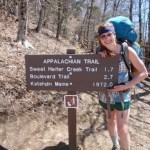 The Appalachian mountains are a hugely popular location for hikers, and the Appalachian Mountain Club (AMC) have a long history of working closely with hikers and other trail users to build/maintain trails, lobby for better protection of the area, raise money and so on.
The Appalachian mountains are a hugely popular location for hikers, and the Appalachian Mountain Club (AMC) have a long history of working closely with hikers and other trail users to build/maintain trails, lobby for better protection of the area, raise money and so on.
For the past decade they’ve been running a citizen science project called Mountain Watch. The aim of the project is to harness the passion of hikers to collect data about the flowers they encounter as they hike the trails.
The hope is that by recruiting hikers to the project, they will not only gain a better insight into the affect climate change has on the behavior of plants in the region, but also raise awareness of the various conservation issues they face in the wake of the changing climate.
Prolonged success
Since the project began in 2004, there have been around 2,000 data sheets completed by volunteers, with over 9,000 unique plant observations made. Volunteers participating in the project are also given training into the ecology of the area, thus deepening their love of the region.
The data generated by the citizen scientists is combined with that from official AMC scientists and naturalists and is used to gain a better understanding of how climate change is affecting things such as the blooming of flowers and the appearance of fruit.
Mountain Watch was modified last year to expand the scope into something known as A.T. Seasons, or Appalachian Trail Seasons. This was done in conjunction with the National Park Service, the National Phenology Network and the Appalachian Trail Conservancy.
The project builds on the success of Mountain Watch, this time seeing habitat ranging from Maine to Georgia studied. The focus is on a much wider range of plants and wildlife to try and understand the full breadth of habitat in the area.
Consistent data is used by all of the partners on the project so it should make collaboration easier, and there is substantial online support, including training, datasheets and various reporting tools.
The data is all added to the National Phenology Networks database, which thus renders it available to other scientists and members of the public.
It’s a nice example of how organizations are increasingly tapping into the diverse and enthusiastic efforts of their stakeholders to achieve some nice results.
Nice idea, I like it. They must get thousands of hikers so if all of them did their little bit it would add up to something great.
I like that. I was in the Lake District hiking recently and there were hundreds of people walking the trails. You can easily see how recruiting those people for some minor tasks would be a valuable addition to the knowledge pool.
Yeah great idea! Walkers enjoy the walks and they will cover a much larger area than a small group of dedicated scientist could. They are also usually lovers of the scenery, so great to be utilised as observers. Good idea 🙂